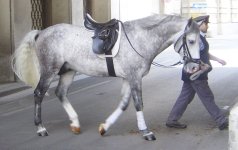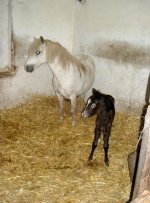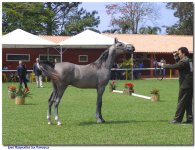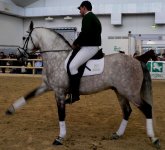♘امیرحسین♞
♘ مدیریت انجمن اسب ایران ♞
Gray or Grey is a coat color of horses, consisting of black skin, and a hair coat that is white, dappled, or white intermingled with hairs of other colors. Gray horses are usually born bay, chestnut, or black, then white hairs begin to appear at or shortly after birth and "gray out" the horse. Graying can occur at different rates--very quickly on one horse and very slowly on another.
A gray horse whose hair coat is completely "white" will still have black skin (except under markings that were white at birth) and dark eyes. This is how most people can tell a gray horse from a white horse. White horses usually have pink skin and frequently have blue eyes. (see White (horse) for more information)
Gray horses appear in many breeds, though the color is most commonly seen in breeds descended from Arabian ancestors. Some breeds that have large numbers of gray-colored horses include the Thoroughbred, the Arabian, the American Quarter Horse, the Percheron, the Andalusian, the Lusitano and the most famous of all gray horses, the Lipizzaner.
Changes in the color of gray horses
A gray foal is born black, bay or chestnut. Then white hairs begin to replace the base or birth color. Usually white hairs are first seen by the muzzle, eyes and flanks, occasionally at birth, and usually by the age of one year. Over time, white hairs replace the birth color and the horse changes slowly to either a rose gray, salt and pepper (or iron gray), or dapple gray. As the horse gets older, the coat continues to lightens further to a pure white or fleabitten gray hair coat. Thus, the many variations of gray coloring in horses are simply intermediate steps that a young horse takes while graying out from a birth color to a hair coat that is completely "white."
Different breeds, and individuals within each breed, take differing amounts of time to gray out. Graying therefore cannot be used to approximate the age of a horse except in the broadest of terms: a very young horse will never have a white coat (unless it is a true white horse), while a horse in its teens usually is completely grayed out. One must also be careful not to confuse the small amount of gray hairs that may appear on some older horses in their late teens or twenties, which do not reflect the gray gene and never cause a complete graying of the horse.
This change in hair color can be confusing. Many new horse owners, not understanding the workings of the gray gene, are disappointed to discover that their dapple gray horse turns completely white a few years later! Other times, people traveling with gray horses who have a pure white hair coat have run into problems with non-horse-oriented officials such as police officers or border guards who are confused over a horse who has papers saying it is "gray" when the horse is front of them appears white!
Salt and Pepper/ Iron/ Steel Gray
This intermediate step is usually seen in foals born black or dark bay. White and black hairs are intermingled together on the body. This is the most common intermediate form of gray, which can give a silvery look to the coat that is sometimes confused with blue roan.
Rose gray
"Rose gray" is an intermediate step for a horse born born a chestnut or bay color. While these colors are "graying out," both red and white hairs are often mixed together on the body. Thus rose gray horses have a slight pinkish tinge to their graying coat. These horses are sometimes confused with roan, but, as described in Horse coat colors sometimes confused with gray below, The gray continues to lighten with age, a roan does not.
Dapple gray
"Dapple gray" consists of a dark hair coat with "dapples," which are dark rings with lighter hairs on the inside of the ring, scattered over the entire body of the animal. It is another possible intermediate step in the graying process of the horse. Dappled grays should not be confused with the slight dappling "bloom" seen on horses that are very healthy or slightly overweight, as "bloom" dapples disappear should the horse lose condition.
The "flea-bitten" gray
A horse that has completely changed its base coat will either be pure white or "flea-bitten" gray. Fleabitten gray is a color consisting of a white hair coat with small speckles or "freckles" of red-colored hair throughout. Most horses who become fleabitten grays still go through a brief period when they are pure white.
The fleabitten pattern, like freckles on a human, can also vary: Some horses may appear almost pure white, with only a few speckles observed on close examination. Others may have so many speckles that they are occasionally mistaken for a roan or even a type of sabino. One unique form of fleabitten gray is the "bloody shouldered" horse. This is an animal that is so heavily flea-bitten on certain parts of the body, usually the shoulder area, that it almost appears as if blood had been spilled on the horse, hence the name. In the traditions of the desert Bedouin people who bred the Arabian horse, the "bloody shoulder" was a prized trait in a war mare and much desired. In some cases, a "bloody shoulder" might in theory also be caused the sabino or rabicano gene acting in addition to a gray coat.
The genetic process that causes the fleabitten color pattern is not well-understood at present.
Horse coat colors sometimes confused with gray
Roan
As noted above some grays in intermediate stages of graying may be confused with a blue roan, strawberry roan or red roan. Some heavily fleabitten grays may also be confused with a red roan. However, roans are easily distinguishable from grays: roan consists of individual white hairs on a dark base coat, usually with the head and legs of the horse darker than the rest of the body. With gray horses, the head is often the first area to lighten, especially around the eyes and muzzle. Also, roans do not lighten with age, while grays always do.
The varnish roan is another unusual coloration, sometimes seen in Appaloosa horses, that, like gray, can change with age, but unlike gray, the horse does not become progressively lighter until it is pure white. Varnish roans are thought to be linked to a gene complex within the Appaloosa breed and are seldom seen elsewhere.
Dun
Some horses with a particular type of dun hair coat known as a "blue dun," grullo, or grulla, appear to be a solid gray. However, this color is caused by the dun gene acting on a black base coat, and horses who are dun have all hairs the same color; there is no intermingling of white and dark hairs. Also, dun horses do not get lighter as they age. This particular color is most commonly seen in the American Quarter Horse, and because Quarter Horses can also be born gray or roan, there is sometimes a bit of confusion amongst aficionados of the breed.
Cream
Horses who are a light cream color are also not grays. These are usually cremello or perlino horses, colors produced by action of a dilution gene. However, if a homozygous gray is bred to a cremello, the gray gene will be dominant.
A gray horse whose hair coat is completely "white" will still have black skin (except under markings that were white at birth) and dark eyes. This is how most people can tell a gray horse from a white horse. White horses usually have pink skin and frequently have blue eyes. (see White (horse) for more information)
Gray horses appear in many breeds, though the color is most commonly seen in breeds descended from Arabian ancestors. Some breeds that have large numbers of gray-colored horses include the Thoroughbred, the Arabian, the American Quarter Horse, the Percheron, the Andalusian, the Lusitano and the most famous of all gray horses, the Lipizzaner.
Changes in the color of gray horses
A gray foal is born black, bay or chestnut. Then white hairs begin to replace the base or birth color. Usually white hairs are first seen by the muzzle, eyes and flanks, occasionally at birth, and usually by the age of one year. Over time, white hairs replace the birth color and the horse changes slowly to either a rose gray, salt and pepper (or iron gray), or dapple gray. As the horse gets older, the coat continues to lightens further to a pure white or fleabitten gray hair coat. Thus, the many variations of gray coloring in horses are simply intermediate steps that a young horse takes while graying out from a birth color to a hair coat that is completely "white."
Different breeds, and individuals within each breed, take differing amounts of time to gray out. Graying therefore cannot be used to approximate the age of a horse except in the broadest of terms: a very young horse will never have a white coat (unless it is a true white horse), while a horse in its teens usually is completely grayed out. One must also be careful not to confuse the small amount of gray hairs that may appear on some older horses in their late teens or twenties, which do not reflect the gray gene and never cause a complete graying of the horse.
This change in hair color can be confusing. Many new horse owners, not understanding the workings of the gray gene, are disappointed to discover that their dapple gray horse turns completely white a few years later! Other times, people traveling with gray horses who have a pure white hair coat have run into problems with non-horse-oriented officials such as police officers or border guards who are confused over a horse who has papers saying it is "gray" when the horse is front of them appears white!
Salt and Pepper/ Iron/ Steel Gray
This intermediate step is usually seen in foals born black or dark bay. White and black hairs are intermingled together on the body. This is the most common intermediate form of gray, which can give a silvery look to the coat that is sometimes confused with blue roan.
Rose gray
"Rose gray" is an intermediate step for a horse born born a chestnut or bay color. While these colors are "graying out," both red and white hairs are often mixed together on the body. Thus rose gray horses have a slight pinkish tinge to their graying coat. These horses are sometimes confused with roan, but, as described in Horse coat colors sometimes confused with gray below, The gray continues to lighten with age, a roan does not.
Dapple gray
"Dapple gray" consists of a dark hair coat with "dapples," which are dark rings with lighter hairs on the inside of the ring, scattered over the entire body of the animal. It is another possible intermediate step in the graying process of the horse. Dappled grays should not be confused with the slight dappling "bloom" seen on horses that are very healthy or slightly overweight, as "bloom" dapples disappear should the horse lose condition.
The "flea-bitten" gray
A horse that has completely changed its base coat will either be pure white or "flea-bitten" gray. Fleabitten gray is a color consisting of a white hair coat with small speckles or "freckles" of red-colored hair throughout. Most horses who become fleabitten grays still go through a brief period when they are pure white.
The fleabitten pattern, like freckles on a human, can also vary: Some horses may appear almost pure white, with only a few speckles observed on close examination. Others may have so many speckles that they are occasionally mistaken for a roan or even a type of sabino. One unique form of fleabitten gray is the "bloody shouldered" horse. This is an animal that is so heavily flea-bitten on certain parts of the body, usually the shoulder area, that it almost appears as if blood had been spilled on the horse, hence the name. In the traditions of the desert Bedouin people who bred the Arabian horse, the "bloody shoulder" was a prized trait in a war mare and much desired. In some cases, a "bloody shoulder" might in theory also be caused the sabino or rabicano gene acting in addition to a gray coat.
The genetic process that causes the fleabitten color pattern is not well-understood at present.
Horse coat colors sometimes confused with gray
Roan
As noted above some grays in intermediate stages of graying may be confused with a blue roan, strawberry roan or red roan. Some heavily fleabitten grays may also be confused with a red roan. However, roans are easily distinguishable from grays: roan consists of individual white hairs on a dark base coat, usually with the head and legs of the horse darker than the rest of the body. With gray horses, the head is often the first area to lighten, especially around the eyes and muzzle. Also, roans do not lighten with age, while grays always do.
The varnish roan is another unusual coloration, sometimes seen in Appaloosa horses, that, like gray, can change with age, but unlike gray, the horse does not become progressively lighter until it is pure white. Varnish roans are thought to be linked to a gene complex within the Appaloosa breed and are seldom seen elsewhere.
Dun
Some horses with a particular type of dun hair coat known as a "blue dun," grullo, or grulla, appear to be a solid gray. However, this color is caused by the dun gene acting on a black base coat, and horses who are dun have all hairs the same color; there is no intermingling of white and dark hairs. Also, dun horses do not get lighter as they age. This particular color is most commonly seen in the American Quarter Horse, and because Quarter Horses can also be born gray or roan, there is sometimes a bit of confusion amongst aficionados of the breed.
Cream
Horses who are a light cream color are also not grays. These are usually cremello or perlino horses, colors produced by action of a dilution gene. However, if a homozygous gray is bred to a cremello, the gray gene will be dominant.




